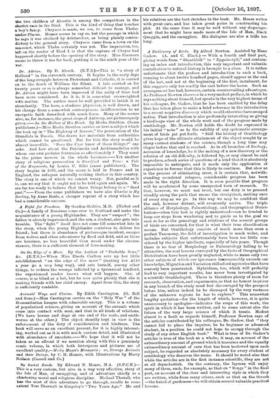A Dictionary of Birds. By Alfred Newton. Assisted by Hans
Gadow. (A. and C. Black.) — With a fourth and final part, giving words from " Sheathbill " to " Zygodactyli," and contain- ing an index and introduction, this very important and valuable contribution to natural history is brought to a close. It is rather unfortunate that the preface and introduction to such a book, running to about twelve hundred pages, should appear at the end of the last, and not at the beginning of the first, instalment, for this suggests only too readily the cart before the horse. Such an arrangement has had, however, certain countervailing advantages. As Professor Newton observes in a very modest preface, in which he says nothing about himself, but speaks in the very highest terms of his colleague, Dr. Gadow, that he has been enabled by the delay that has taken place to make a brief reference in the introduction to a recent negative discovery which would otherwise have escaped notice. That introduction is also profoundly interesting as giving a bird's-eye view of the whole work and of the progress made by ornithology. Mr. Newton still holds the doubt he expressed in his initial " note " as to the validity of any systematic arrange- ment of birds yet put forth. "Still the history of Ornithology gives hope of the ultimate attainment of the object sought by so many earnest students of the science, though a long time may elapse before that end is reached. As in all branches of Zoology, accession of knowledge, be it the making of a new discovery or the solution of an old difficulty, is followed by, or may almost be said to produce, afresh series of questions of a kind that it is absolutely impossible to anticipate, and it needs only the application of experience to foresee that this is likely to continue. But slow as is the process of eliminating error, it is certain that, notwith- standing occasional relapses, considerable progress has been made in the right direction. It is even possible that progress will be accelerated by some unexpected turn of research. To that, however, we must not trust, but our duty is to proceed steadily along the path that seems the straightest, making sure of every step as we go. In this way we may be confident that the end, however distant, will eventually arrive. The triple alliance of Morphology, Palmontology, and Geographical Distri- bution—when this last is rightly understood—can be trusted to keep our steps from wandering and to guide us to the goal we seek so far as the genealogy and relations of the several groups of birds are concerned, for that is what their true classification means. But Ornithology consists of much more than even a perfect Taxonomy, the field of investigation is much wider, and includes subjects that unfortunately have been too little con- sidered by the higher intellects, especially of late years. Though there is no fear of Morphology or Palmontology failing to be attractive, the real lessons conveyed by the facts of Geographical Distribution have been greatly neglected, while to name only two other subjects of which our ignorance immeasurably exceeds our knowledge, Migration and Variation still afford mysteries that have scarcely been penetrated. Hybridism, too, which will probably lead to very important results, has never been investigated by a scientific Ornithologist. There is therefore plenty of room for research, observation, and experiments, so that no honest inquirer in any branch of the study need feel discouraged by the prospect before him, unless indeed he be dismayed by the very vastness of the unknown regions he has to explore." This somewhat lengthy quotation—for the length of which, however, it is quite unnecessary to apologise—indicates the scope of this work, the spirit in which it has been written, and to some extent also the future of the very large science of which it treats. Modest almost to a fault as regards himself, Professor Newton says of the articles contributed by his colleague, Dr. Gadow, that "they cannot fail to place the inquirer, be he beginner or advanced student, in a position he could not hope to occupy through the study of any other English book." What is true of Dr. Gadow's articles is true of the book as a whole; it may, on account of the extraordinary amount of ground which it traverses and the equally extraordinary amount of care that has been bestowed upon each subject, be regarded as absolutely neceassry for every student of ornithology who deserves the name. It should be noted also that while the articles are in the first instance scientific, they are not at all dryasdustish. On the contrary, the layman will enjoy many of them, such, for example, as that on " Songs" in the final part, on account of the clear and interesting style in which they are written, while from many others, such as that on the thrush —the hated of gardeners—he will obtain several valuable practical lessons.






































 Previous page
Previous page